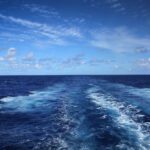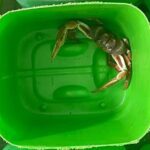Anglers use nets to land fish and fisheries scientists use networks to study the relationships between resource consumers and natural resources. One such scientist is Dr. Christopher Chizinski, Assistant Professor of Human Dimensions of Wildlife Management at the University of Nebraska-Lincoln. In a new study in the Canadian Journal of Fisheries and Aquatic Sciences, Dr. Chizinski and colleagues use a specific type of network analysis to model connections between two specific entities: anglers and their catch of the day.
The relationship between anglers and fish is complex. If you are an angler, you may know that despite the best of your abilities you do not always catch the species of fish that you are seeking. By choosing to fish with a lure or live bait, you may be eliminating the potential of catching some species, but it is unlikely you will only catch what you are seeking. This is because no gear or technique is entirely exclusive. To further complicate matters, you are often not the only angler on the waterbody. Other anglers have different skills, may use different gear or bait, may be seeking different species, and have different motivations for fishing.
If you’re a fish, you may be living in a large or small body of water with many or few other species. You may compete with other species for food and may be more (or less) vulnerable to capture by anglers.
Given this complexity between heterogeneous angler groups and the fish community, we need tools to represent the multiple relationships so that we can understand the influence of angling on aquatic ecosystems.
Network analysis is increasingly used to study social structures in human systems (e.g., interactions among fishery stakeholders) as well as relationships within populations, communities, and ecosystems. Networks represent individuals, people, species, or things (e.g., lakes) as nodes (usually represented as a circle or square) and the connections between those nodes called edges (usually represented as a line between the nodes). The strength of the connection between the nodes is represented by the width of the edge; wider lines indicate greater ties between a set of nodes.
The strength of network theory is that, by reducing a complex system to a set of nodes connected by lines, we can apply mathematical tools to analyze the structure (and dynamics) of the system. There are several metrics that can be used to describe the structure: the network in its entirety, a level in the network (see below for examples), or the influence of a node on the network itself.
One special type of network is the bipartite network, which describes the relationships that occur between two different types of entities. In an ecological setting, this type of network is used to describe relationships in pollinator–plant, parasite–host, and predator–prey communities.
In our new article in the Canadian Journal of Fisheries and Aquatic Sciences, we used the bipartite network to describe the relationship between anglers and the fish species that they catch (intended or not) among 42 freshwater reservoirs in Nebraska, USA. Using information compiled from over 27,000 face-to-face interviews with anglers, we developed networks at each waterbody relating anglers, grouped by the species that were their primary target (i.e., “species-targeting angler groups”), and the fish they actually caught.
To illustrate how these networks can be used to describe a recreational fishery, we constructed a network from angler interviews at Sherman Reservoir, a waterbody of medium complexity (i.e., moderate number of angler groups [6] and medium number of species caught [12]).
 The top level of the network is the angler groups (yellow nodes) and the bottom level is the species caught (teal nodes). The width of the nodes at the top and bottom represent the relative catch per unit effort (i.e., number of fish caught per angler per hour). There are a couple of interesting things that pop out:
The top level of the network is the angler groups (yellow nodes) and the bottom level is the species caught (teal nodes). The width of the nodes at the top and bottom represent the relative catch per unit effort (i.e., number of fish caught per angler per hour). There are a couple of interesting things that pop out:
- More species are being caught than are being sought; anglers were only targeting six species but twice as many species (12) were reported being caught.
- Anglers targeting different species have very different levels of interaction with other fish species (bycatch)—while anglers targeting largemouth bass don’t catch anything else, anglers targeting walleye or “anything” catch the most species.
- Some fish are often caught by anglers that do not seek them (e.g., crappie are caught by anglers targeting walleye and white bass).
- Several species (green sunfish, northern pike, common carp, bluegill, and yellow perch) are caught rarely and predominately as bycatch.
- Walleye is the species caught by the most number of angler groups.
This network provides a visualization that allows a holistic view of what is being caught in a waterbody. This view can help managers identify angler groups that are susceptible to capturing aquatic invasive species (such as white perch). This view can also help identify non-target species that are vulnerable to capture by angler groups, which could be important for species of concern.
In addition to exploring how bipartite networks could be used in fishery management, we investigated how the angler-catch bipartite network structure changes with waterbody size. In our study, the 42 waterbodies ranged from 1 to 12113 ha. We found that the number of angler groups and the number of species caught increased with increasing waterbody size. The number of ties between the angler groups and species caught also increased with the waterbody size, suggesting that in larger waterbodies any given angler group is interacting with more species.
The use of bipartite networks to assess the interactions between anglers and fish provides an important visualization of the complex relationships in recreational fisheries. From an ecological perspective, one can improve understanding of interactions between anglers and fish, whether targeted or not, by examining angler-catch interaction networks. Sharing these interaction networks and discussing the implications of them with resource managers can improve understanding from an applied perspective and could lead to better fishery management and conservation practices.
The article entitled “Bipartite networks improve understanding of effects of waterbody size and angling method on angler–fish interactions” is available on the Canadian Science Publishing website.




